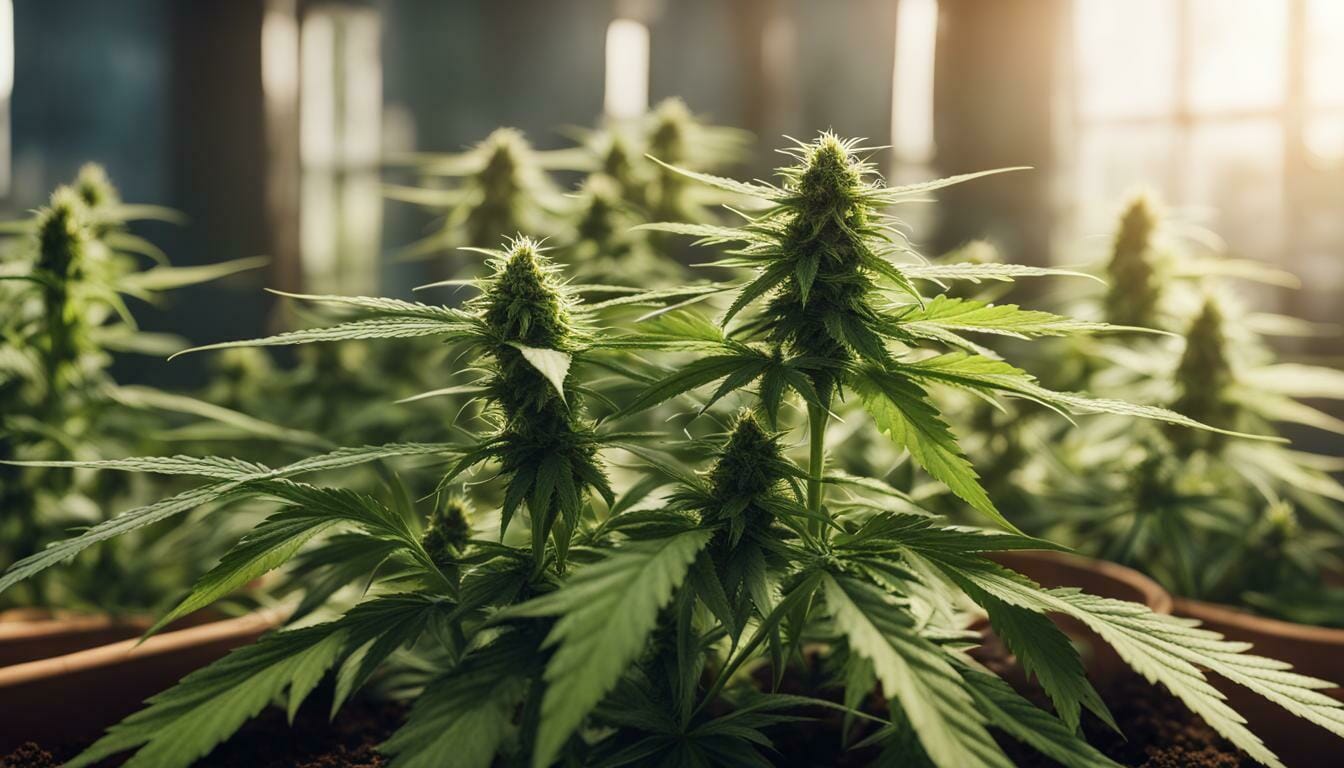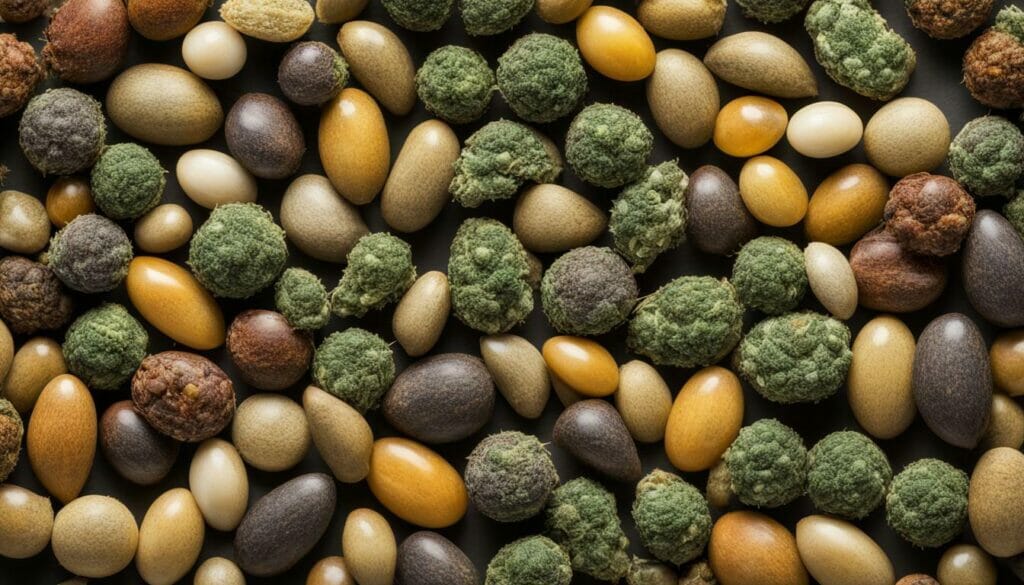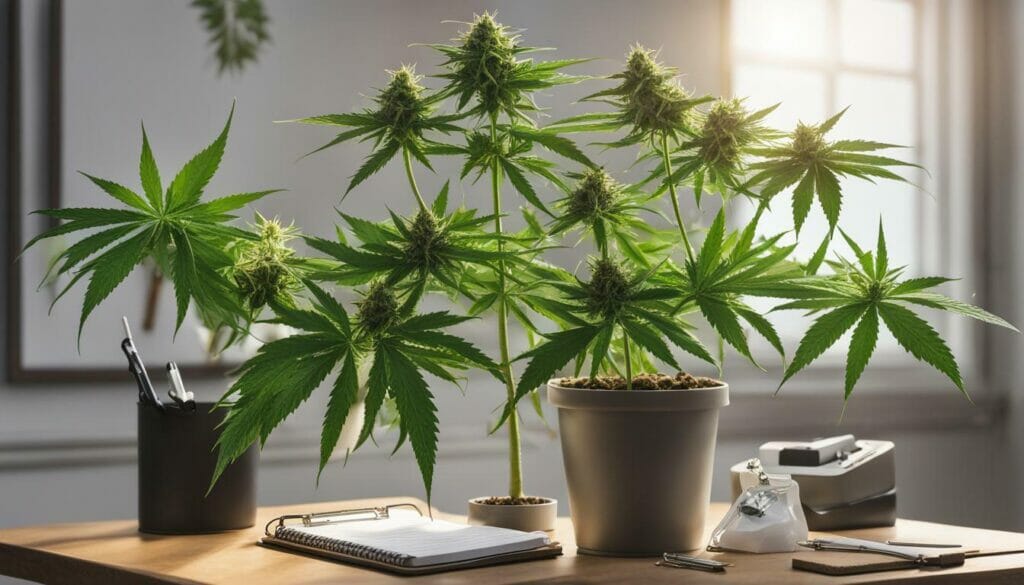Common Mistakes To Avoid When Breeding Cannabis: A Guide

Welcome to our guide on common mistakes to avoid when breeding cannabis. Breeding cannabis can be a rewarding experience, but it requires careful planning and execution to achieve the desired results. In this guide, we will provide insights on the common pitfalls to avoid for successful cannabis breeding. Whether you are an experienced breeder or just starting, this guide will help you avoid the most common mistakes and improve your chances of success.
Key Takeaways
- Starting with high-quality seeds is crucial for successful breeding.
- Understanding cannabis genetics is essential for avoiding mistakes.
- Creating an optimal breeding environment is important for plant growth and development.
- Using effective breeding techniques can improve outcomes.
- Maintaining thorough records is critical for successful breeding.
- Maintaining plant health and providing proper nutrition is essential.
- Identifying and eliminating male plants is crucial for desired outcomes.
- Patience and proper planning are necessary for successful breeding.
- Adequate testing and selection can improve breeding outcomes.
Choosing Low-Quality Seeds
One of the most common mistakes made in cannabis breeding is starting with low-quality seeds. Choosing inferior seeds can lead to an unsuccessful breeding process and produce undesirable outcomes.
| Problem | Solution |
|---|---|
| Low germination rate | Choose seeds that are fresh and have a high germination rate. Look for reputable seed companies that provide detailed information on the quality of their products. |
| Undesirable traits | Research the genetics of the strain you want to breed and choose seeds that possess the desired traits. Avoid seeds with unknown or unstable genetics. |
High-quality seeds are the foundation for successful breeding. Take the time to research and select the best seeds for your breeding projects. It will save you time, money, and frustration in the long run.

Lack of Genetic Knowledge
When it comes to breeding cannabis, having a solid understanding of genetics is crucial. Without this knowledge, common mistakes can easily occur leading to undesirable breeding outcomes.
One common pitfall is failing to consider the genetic traits of the parent plants, leading to unpredictable offspring. Before starting the breeding process, it is essential to research the genetic makeup of the parent plants and identify desirable traits to preserve and enhance in the offspring.
Furthermore, it is important to understand the difference between dominant and recessive genes. Neglecting this crucial factor can result in undesirable outcomes and a lack of control over the breeding process.
It is also important to consider the stability of the genetics of the parent plants. Stable genetics ensure that the offspring will have predictable traits, while unstable genetics can lead to wildly varying results.
Without a solid understanding of cannabis genetics, it is easy to make mistakes that can have long-lasting effects on the breeding process. To avoid common pitfalls, take the time to research and understand cannabis genetics before beginning the breeding process.

Poor Breeding Environment
A common mistake in cannabis breeding is not creating an optimal environment for the plants to grow and thrive. Factors such as temperature, humidity, and lighting can all play a significant role in the success of the breeding process.
One mistake many breeders make is not providing enough light for the plants. Cannabis plants require a minimum of 12 hours of light per day to grow and develop properly. It’s important to provide consistent lighting and avoid sudden changes in light conditions, which can stress the plants and negatively impact their growth.
| Environmental Factors to Consider: | Best Practice: |
|---|---|
| Temperature | Maintain a consistent temperature range of 68-77°F (20-25°C) during the day and 59-68°F (15-20°C) at night. |
| Humidity | Keep the humidity level between 40-60% during the vegetative stage and 40-50% during the flowering stage. |
| Lighting | Provide a minimum of 12 hours of consistent light per day, avoiding sudden changes in light conditions. |
| Airflow | Ensure proper ventilation and air circulation to prevent mold growth and promote healthy plant development. |
It’s also essential to maintain appropriate humidity levels and proper airflow to prevent mold growth and promote healthy plant development. Adequate ventilation and air circulation are crucial factors in creating an optimal breeding environment.
By ensuring a consistent and ideal breeding environment, you can increase the likelihood of successful breeding and produce healthy and high-quality cannabis plants.

Ineffective Breeding Techniques
Using ineffective breeding techniques is one of the common mistakes to avoid when breeding cannabis. Often, novice breeders may not know the right breeding techniques or may be using outdated methods that don’t work well with modern cannabis strains. This can lead to undesirable traits appearing in the offspring, poor yields, and an overall disappointing breeding experience.
To improve your breeding techniques, consider using the latest breeding methods such as cross-breeding, backcrossing, and selfing. These techniques enable you to mix desirable traits from different strains and create offspring with the desired characteristics.
Tip: Before you settle for any breeding technique, ensure you have the necessary knowledge, tools, and skills to execute it successfully. You can learn from experienced breeders, attend seminars, or watch tutorials on reputable online platforms.
| Breeding Technique | Description |
|---|---|
| Crossbreeding | This involves breeding two different strains to create a hybrid offspring with unique characteristics. |
| Backcrossing | This involves breeding a hybrid offspring with one of the parent strains to accentuate desirable traits. |
| Selfing | This involves breeding a female plant with itself to create offspring that share the same genetic makeup as the parent. |

It’s also essential to use the right breeding tools such as pollen sacs, breeding tents, and clean shears. Breeding tents give you control over the breeding environment, while clean shears prevent contamination and ensure healthy breeding. Pollen sacs can be used to collect pollen from male plants to be used for crossbreeding.
Tip: To achieve the desired outcome, it’s best to experiment with different breeding techniques and tools for a better understanding of the breeding process.
Lack of Record-Keeping
One of the most critical elements of successful cannabis breeding is proper record-keeping. It’s essential to document every step of the process, including the strains used, the dates of breeding and pollination, and any environmental factors that may have impacted the plants.
Without accurate and comprehensive records, it’s nearly impossible to replicate successful breeding outcomes or troubleshoot any issues that may arise during the process. The lack of record-keeping can also lead to confusion and mistakes, such as accidentally using low-quality seeds or breeding with the wrong male plant.
When it comes to record-keeping, it’s best to err on the side of caution and document as much information as possible. Keep a journal or use a spreadsheet to track every detail of the breeding process, including plant health, growth rates, and any changes in environmental conditions.
By maintaining thorough and well-organized records, you’ll not only increase your chances of a successful breeding outcome but also have valuable data for future breeding projects.
Remember: accurate record-keeping is the cornerstone of successful cannabis breeding.

Remember: accurate record-keeping is the cornerstone of successful cannabis breeding.
Neglecting Plant Health and Nutrition
Ensuring plant health and proper nutrition is crucial in the cannabis breeding process. Neglecting these aspects can lead to stunted growth, poor yields, and susceptibility to diseases and pests.
One common mistake is over-fertilizing or using the wrong type of fertilizer, which can damage plants and affect their development. It’s important to understand the nutrient needs of cannabis plants at different stages of growth and use appropriate fertilizers and supplements.
Proper watering is also essential for plant health. Over-watering can lead to root rot and other problems, while under-watering can stunt growth and reduce yields. It’s essential to monitor the soil moisture and ensure adequate drainage.
In addition to nutrition and watering, it’s important to maintain a clean and pest-free environment for plants. Regularly inspecting plants for signs of pests and diseases and taking appropriate action can help prevent problems from spreading.
Remember to also pay attention to environmental conditions, such as temperature and humidity, as they can affect plant health and growth. Maintaining a stable and optimal environment can help ensure successful breeding outcomes.
By prioritizing plant health and nutrition, you can avoid many common mistakes in cannabis breeding and optimize your chances of success.

By prioritizing plant health and nutrition, you can avoid many common mistakes in cannabis breeding and optimize your chances of success.
Failure to Identify and Eliminate Male Plants
It is crucial to identify and eliminate male plants when breeding cannabis, as they can pollinate female plants and alter the genetic makeup of the offspring. Failing to identify and remove male plants can result in lower yields and a reduced potency of the final product.
Male plants can be identified by their early development of pollen sacs, which resemble small clusters of grapes. Female plants, on the other hand, develop white hairs known as pistils. It is essential to carefully monitor the plants during the flowering stage to prevent any pollination.
One effective method of sexing cannabis plants is by using a technique called “cloning“. This involves taking a cutting from a plant and forcing it to flower early. This process will reveal the plant’s sex, allowing for the identification and removal of any male plants before they have a chance to pollinate.
It is essential to stay vigilant and regularly inspect plants for any signs of male development. Removing male plants promptly can ensure the success of the breeding process and result in a high-quality final product.

Lack of Patience and Proper Planning
While breeding cannabis can be an exciting and rewarding process, it requires patience and proper planning for successful outcomes. Rushing through the breeding process or failing to properly plan can lead to mistakes that can ultimately impact the results.
One common mistake in breeding cannabis is impatience. It can be tempting to rush through the process to see results quickly, but this can lead to mistakes in selection and testing. It’s important to take the time to properly test and select plants to ensure the desired traits are present.
Proper planning is also essential in cannabis breeding. This includes setting goals for the breeding process, choosing appropriate breeding methods, and creating a plan for managing male plants. Without a clear plan, mistakes can easily occur that can impact the success of the breeding process.
To ensure patience and proper planning in cannabis breeding, it’s important to follow a step-by-step process and document each stage of the process. This will provide a clear roadmap for the breeding process and help to avoid mistakes that can impact the results.
By taking the time to properly plan and approach the breeding process with patience, breeders can increase their likelihood of success and achieve the desired results.

By taking the time to properly plan and approach the breeding process with patience, breeders can increase their likelihood of success and achieve the desired results.
Inefficient Testing and Selection
One of the biggest mistakes in breeding cannabis is insufficient testing and selection. It’s important to test and evaluate each strain throughout the breeding process to ensure desired traits are being passed down. This includes testing for potency, aroma, taste, and growth characteristics.
Without proper testing, it’s difficult to determine which plants are worth keeping for future breeding and which ones should be eliminated. Additionally, selecting plants based solely on physical appearance can lead to the passing down of unwanted traits.
To avoid these mistakes, it’s crucial to establish clear selection criteria and stick to them throughout the breeding process. This can include evaluating plants through blind testing, monitoring growth and development over time, and keeping detailed records of each plant’s performance.
| Tip: | Utilize modern technology, such as DNA testing, to identify and track desired genetic traits throughout the breeding process. This can help streamline selection and ensure successful outcomes. |
|---|
Remember, the success of cannabis breeding relies heavily on proper testing and selection. By taking the time to test and evaluate each strain, breeders can ensure the desired traits are being passed down and create high-quality strains that stand out in the market.

Conclusion
Successful cannabis breeding requires careful attention to detail and a thorough understanding of the plant’s genetics and needs. By avoiding common mistakes and implementing best practices, growers can achieve desired outcomes and produce high-quality cannabis strains.
Remember to always start with high-quality seeds, gain a deep understanding of cannabis genetics, create an optimal breeding environment, use effective breeding techniques, maintain thorough records, prioritize plant health and nutrition, identify and eliminate male plants, approach breeding with patience and proper planning, and conduct sufficient testing and selection.
By following these tips and recommendations, growers can avoid common pitfalls and produce superior cannabis strains. Happy breeding!
FAQs
Q: What are some common mistakes to avoid when breeding cannabis?
A: Common mistakes to avoid when breeding cannabis include choosing low-quality seeds, lacking genetic knowledge, creating a poor breeding environment, using ineffective breeding techniques, neglecting record-keeping, neglecting plant health and nutrition, failing to identify and eliminate male plants, lacking patience and proper planning, and insufficient testing and selection.
Q: Why is choosing high-quality seeds important for successful cannabis breeding?
A: Choosing high-quality seeds is crucial for successful cannabis breeding because low-quality seeds can lead to poor genetic traits, weak plants, and lower chances of producing desired phenotypes. Starting with high-quality seeds increases the likelihood of achieving desirable traits and healthy offspring.
Q: How can I gain better knowledge of cannabis genetics for breeding?
A: To gain better knowledge of cannabis genetics for breeding, you can study resources such as books, research articles, and online forums dedicated to cannabis genetics. Additionally, attending workshops or courses on genetics can provide valuable insights and practical knowledge.
Q: What factors should I consider to create an optimal breeding environment for cannabis?
A: To create an optimal breeding environment for cannabis, consider factors such as temperature, humidity, lighting, air circulation, and cleanliness. Maintaining stable and suitable conditions in these areas will promote healthy plant growth and increase the chances of successful breeding.
Q: What are some effective breeding techniques to improve outcomes?
A: Some effective breeding techniques to improve outcomes include selective breeding, controlled pollination, utilizing breeding tents or chambers, and keeping detailed records of breeding experiments. These techniques help to increase the likelihood of producing desired traits and minimizing the occurrence of undesirable ones.
Q: Why is record-keeping important during the breeding process?
A: Record-keeping is important during the breeding process as it allows you to track and analyze the results of your breeding experiments. It helps identify successful crosses, track genetic traits, and make informed decisions for future breeding efforts. Accurate records serve as a valuable reference and learning tool.
Q: How can I ensure optimal plant health and nutrition during breeding?
A: To ensure optimal plant health and nutrition during breeding, it is crucial to provide balanced nutrient solutions, proper watering techniques, and regular monitoring of plant health. Regularly inspecting plants for signs of nutrient deficiencies or pest infestations and addressing them promptly will help maintain healthy plants.
Q: Why is it important to identify and eliminate male plants during breeding?
A: Identifying and eliminating male plants during breeding is important to prevent them from pollinating female plants and ruining the desired breeding results. Male plants produce pollen, which leads to seed production rather than focusing on the desired characteristics of the female plants.
Q: How can I practice patience and proper planning when breeding cannabis?
A: Practicing patience and proper planning when breeding cannabis involves setting realistic timelines, understanding the breeding process takes time, and resisting the urge to rush or make hasty decisions. Proper planning includes researching, organizing breeding schedules, and considering the desired traits and goals before initiating a breeding project.
Q: Why is sufficient testing and selection important during breeding?
A: Sufficient testing and selection during breeding are important to identify and retain plants that exhibit the desired traits. Through rigorous testing and selection processes, breeders can ensure that the offspring possess the characteristics they are aiming for, leading to higher-quality and more desirable cannabis strains.
Suggested Articles
;)
;)
;)




 11 Sep 2025
11 Sep 2025  23 min read
23 min read


 July 10, 2024
July 10, 2024 


RESPONSES (0)
No responses yet. Be the first to respond!